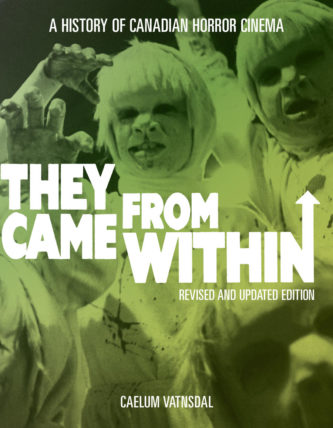 By CAELUM VATNSDAL (Arbeiter Ring Publishing; 2004)
By CAELUM VATNSDAL (Arbeiter Ring Publishing; 2004)
This well researched and eminently readable overview is the closest thing there is to a bible on Canadian horror cinema, a subject that isn’t discussed much. There’s a reason for that, of course, as author Caelum Vatnsdal acknowledges in his opening line: “It’s no exaggeration to say that the history of Canadian fiction filmmaking is, in the main, one of catastrophe, neglect and wasted potential.” That claim is born out by the book’s contents, which include lengthy write-ups on better-left-unmentioned bummers like THE AMITYVILLE CURSE, THINGS, NIGHT OF THE DEMONS 3 and MASSACRE UP NORTH.
Yet Vatnsdal is also careful to talk up the (admittedly small) handful of quality Canadian made horror films like DEATHDREAM, SHIVERS, VIDEODROME and PIN, while outlining the careers of Canuck auteurs like William Fruet and (of course) David Cronenberg, whose work up to THE FLY (1986) is voluminously profiled. Vatnsdal also provides an authoritative mini-history of Canadian feature filmmaking and the first-ever Canadian horror movie: 1961’s THE MASK, which was also Canada’s first 3-D movie. It was followed five years later by THE VULTURE and THE PLAYGIRL KILLER, and in 1967 by the formation of the Canadian Film Development Corporation.
A flood of Canuck horror fests ensued, some of them good (see above) but most of them not. Then came the so-called tax shelter years of the late 1970s and early 80s, apparently a “deeply ignoble time in Canadian history.” The catalyst was a tax loophole that allowed for a 100 percent write-off on Canadian-funded motion pictures, which naturally led to a flood of crappy movies. It was the tax shelter era that gave us crapfests like HUMONGOUS, CURTAINS, TERROR TRAIN, PHOBIA, DEATH SHIP, GHOSTKEEPER and VISITING HOURS (and, to be fair, some worthwhile films like THE BROOD, THE CHANGELING and FUNERAL HOME).
Following the demise of the tax shelters in 1984 things were quiet on the Canadian horror front. Vatnsdal characterizes the majority of Canada’s late 80’s/early 90’s horror output as “straight-to-video junk” like GRAVEYARD SHIFT, an ambitious horror-art film that was mutilated, apparently, by its American producers, and William Fruet’s ridiculous BLUE MONKEY (don’t ask). Yet the 2000 release of GINGER SNAPS revitalized the genre, opening the way for a number of quality Canadian-made horror films—even though most of them (5150 ELM’S WAY, PONTYPOOL, etc.) turned up after this book was published.
THEY CAME FROM WITHIN’S scope is admirably thorough overall, yet for some unfathomable reason Renee Daalder’s HABITAT (1997) is left out. Also, I wish the author had broadened his scope a bit to encompass quasi-horrific cult films like THE GROCER’S WIFE and SPIKE OF LOVE. If nothing else, their inclusion would have added some quality film offerings, of which this book could have used a lot more.
